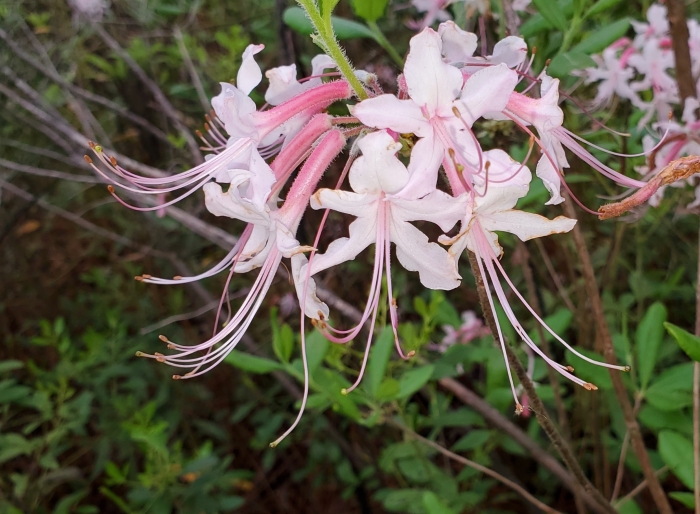Piedmont Azalea
(Rhododendron canescens)
Piedmont Azalea (Rhododendron canescens)
/
/

Laura Gaudette
CC BY 4.0
Image By:
Laura Gaudette
Recorded By:
Copyright:
CC BY 4.0
Copyright Notice:
Photo by: Laura Gaudette | License Type: CC BY 4.0 | License URL: http://creativecommons.org/licenses/by/4.0/ | Rights Holder: Laura Gaudette | Publisher: iNaturalist | Date Created: 2021-04-16T09:29:47-07:00 |








































































Estimated Native Range
Summary
Rhododendron canescens, commonly known as Piedmont Azalea, is a deciduous shrub native to moist, acidic soils of pine and mixed hardwood forests, forest edges, and along stream banks in the Southeastern United States. It typically grows to a height of 6-15 feet (1.8-4.5 meters) and a width of 6-12 feet (1.8-3.7 meters). The plant features a rounded form with clusters of fragrant, funnel-shaped flowers that range in color from pale pink to white, often with a blush of yellow or pink in the throat, blooming in early spring. The flowers are quite showy and attract pollinators such as butterflies and hummingbirds.
Piedmont Azalea is valued for its fragrant and showy flowers, which make it a popular choice for woodland gardens, naturalized areas, and as a specimen plant. It thrives in part shade to full shade, requiring acidic, well-drained soils rich in organic matter. Consistent moisture is important, but the plant is somewhat drought-tolerant once established. It can be susceptible to pests like lace bugs and diseases such as root rot if not in well-drained soil. Gardeners should be aware that all parts of the plant are toxic if ingested.CC BY-SA 4.0
Piedmont Azalea is valued for its fragrant and showy flowers, which make it a popular choice for woodland gardens, naturalized areas, and as a specimen plant. It thrives in part shade to full shade, requiring acidic, well-drained soils rich in organic matter. Consistent moisture is important, but the plant is somewhat drought-tolerant once established. It can be susceptible to pests like lace bugs and diseases such as root rot if not in well-drained soil. Gardeners should be aware that all parts of the plant are toxic if ingested.CC BY-SA 4.0
Plant Description
- Plant Type: Shrub
- Height: 6-8 feet
- Width: 6-12 feet
- Growth Rate: Slow
- Flower Color: Pink, White
- Flowering Season: Spring
- Leaf Retention: Deciduous
Growth Requirements
- Sun: Part Shade
- Water: Medium
- Drainage: Medium, Slow
Common Uses
Bee Garden, Bird Garden, Border Plant, Butterfly Garden, Fragrant, Hummingbird Garden, Rabbit Resistant, Showy Flowers, Street Planting
Natural Habitat
Moist, acidic soils of pine and mixed hardwood forests, forest edges, and along stream banks in the Southeastern United States
Other Names
Common Names: Piedmont Azalea
Scientific Names: , Rhododendron canescens, Azalea canescens, Rhododendron canescens var. canescens, Azalea candida, Rhododendron canescens var. subglabrum, Azalea lutea, Rhododendron canescens var. candidum, Azalea periclymena, Anthodendron nudiflorum
GBIF Accepted Name: Rhododendron canescens (Michx.) G.Don